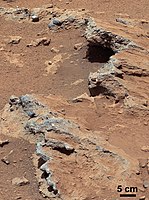
Photo from wikipedia
In this study, we present new data on the δ7Li values and Li/(Ca+Mg) ratios of carbonate cores from the Great Bahama Bank (Clino, Unda), a deep water core off of… Click to show full abstract
In this study, we present new data on the δ7Li values and Li/(Ca+Mg) ratios of carbonate cores from the Great Bahama Bank (Clino, Unda), a deep water core off of the bank top (ODP Leg 166 Site 1007), and the coralline Key Largo Limestone. We use these samples to evaluate the influence of meteoric diagenesis, marine burial diagenesis, and dolomitization on the Li isotope system in carbonates. We find that recrystallization of aragonite to low-Mg calcite in the presence of meteoric fluids results in a systematic decrease of the Li/(Ca+Mg) ratio in Clino, Unda and Key Largo samples, due to the lower Li/(Ca+Mg) ratio in meteoric fluids compared to seawater. For Li isotopes, we observe that the δ7Li of meteorically altered low-Mg calcite is +22.0±3.8‰ (n=28, 1σ), which is coincidentally similar to the original aragonite-rich sediments (+22±1‰ in the Bahamas, +18±1‰ in Key Largo), but with a larger variability (from +15 to +27‰). We interpret these features as reflecting the overprinting of primary Li during meteoric alteration with a highly variable isotope signature that may be controlled by a combination of local porewater and/or global climatic conditions; in either case, meteoric diagenesis produces isotopic signatures that are unrelated to seawater composition. In contrast, marine burial diagenesis and dolomitization of Clino and Unda sediments under “fluid-buffered” conditions result in Li isotope composition that is similar (+30.2±1.5‰, n=36, 1σ) to modern seawater (+31‰). For Site 1007, the δ7Li values range between +23 permil and +31 permil. We interpret this range as reflecting a combination of varying diagenesis style (fluid to sediment-buffered) and varying contribution of calcite derived from pelagic sediments, with distinct isotopic composition due to primary mineralogy. Altogether, our results show that diagenesis does not invalidate the use of bulk carbonates for deriving Li isotope paleo-records, but the reliability of past carbonates as recorders of seawater δ7Li values will depend on carefully characterizing their diagenetic history.
Journal Title: American Journal of Science
Year Published: 2020
Link to full text (if available)
Share on Social Media: Sign Up to like & get
recommendations!